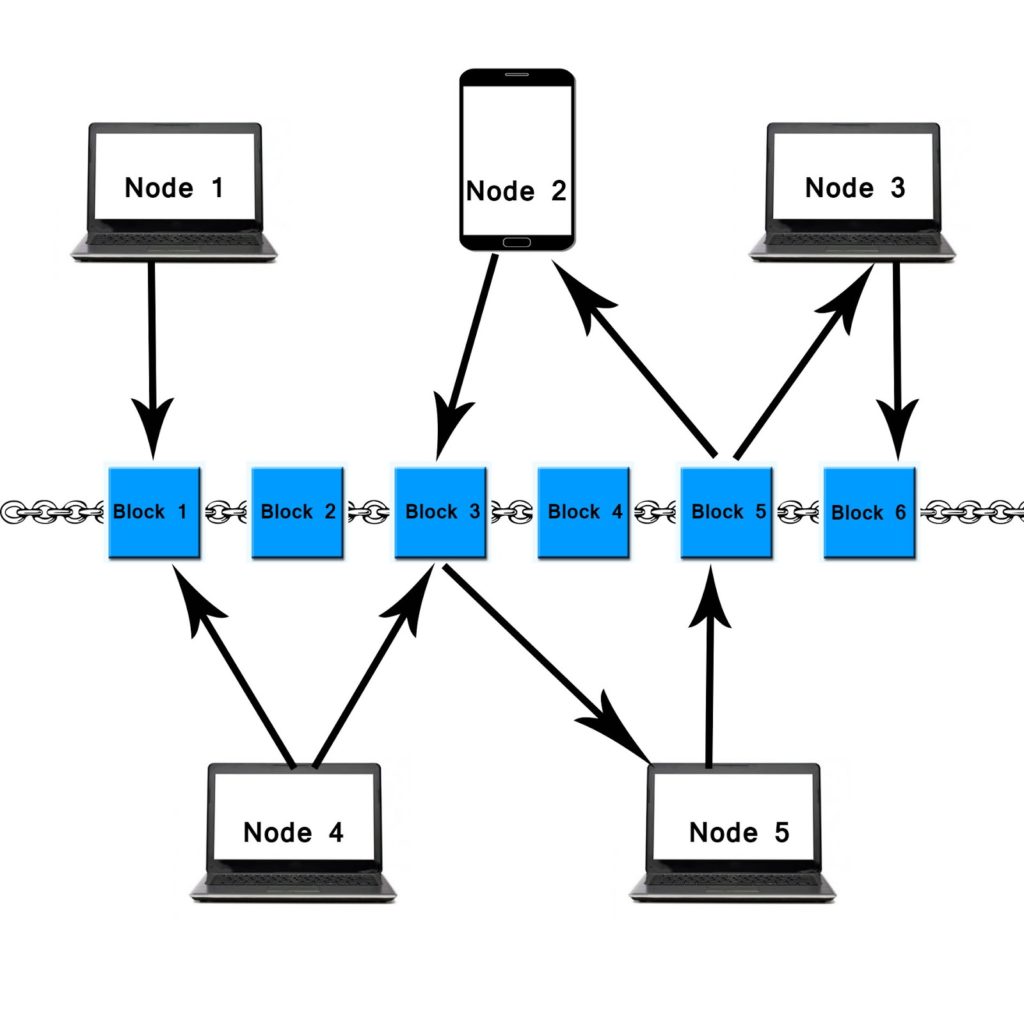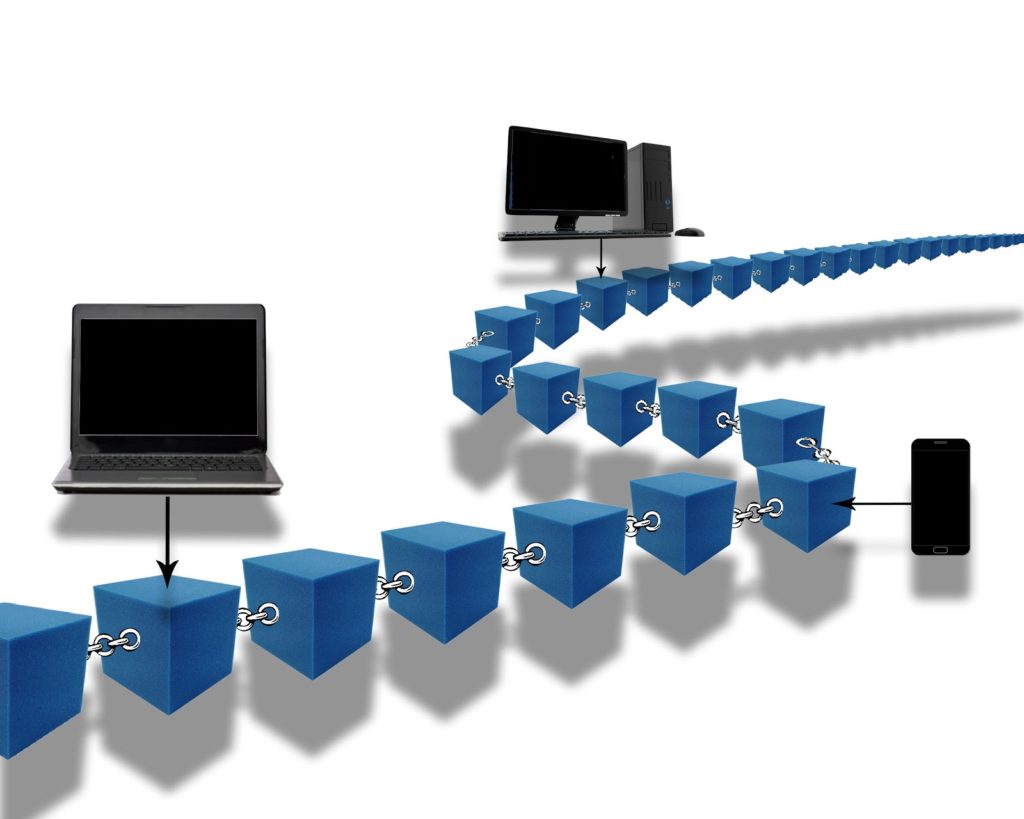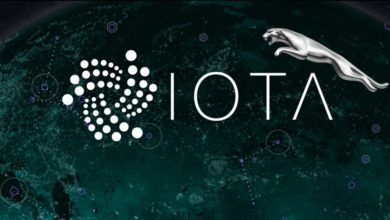
We have all heard of the blockchain or distributed ledger technology (DLT), but have you ever wondered how does it work?
Blocks as Storage of Data
The name blockchain itself reveals that the core of the system are blocks upon which the data is stored and distributed. Blocks can vary in size dependable on which blockchain system we are talking about.
For example, we already talked about the fundamental differences between Bitcoin (BTC), whose blocks are 1MB large, and its hard forks, which can have much more space, like Bitcoin Cash (BCH) and its 8MB blocks.
The System is a Network
Blockchain, as a peer-to-peer ecosystem, forms a network of nodes. Every node, provided that it has the right private keys, can access data on the network.

Peer-to-peer means that there is no central storage space for data, on the contrary, all the information is shared by the network participants.
All nodes on the blockchain can interact with one another, thus making transactions of cryptocurrencies, tokens or records between users possible, and cryptography ensures the integrity and security of the information.
Transactions Have to be Verified
All transactions on the blockchain have to be verified by the consensus algorithms.
There are different consensus mechanisms integrated into various blockchain networks.
Proof-of-Work (PoW)
The most known is Proof-of-Work (PoW) algorithm, which is used by some of the most prominent blockchain systems like Bitcoin and Ethereum (ETH).
In PoW, miners, who are using powerful processors, verify transactions, for which they are rewarded with that blockchain’s native cryptocurrency.
However, the mining mania, which reached its climax during the second half of 2017, showed us that PoW may not be an optimal consensus reaching mechanism due to the high power consumption, so even Ethereum, which became famous partially for high mining rewards, began considering migrating to PoS.
Proof-of-Stake (PoS)
In PoS, transactions are verified by nodes put on staking option, which contain a certain amount of the network’s respective cryptocurrency. Staking nodes receive a reward for their contribution to the network.
Lately, developers are looking to improve on that system, so they have come up with…
Delegated-Proof-of-Stake (DPoS)
Although similar to PoS, the Delegated-Proof-of-Stake has some notable differences.
On DPoS networks, token holders vote for groups who will be system’s representatives and transaction authenticators.
The most known example of DPoS is EOS network, where EOS token holders voted for 21 block producers who are managing and securing the network, and in turn, also receive very high rewards in EOS cryptocurrency.
Proof-of-Authority (PoA)
Proof-of-Authority is a consensus reaching system where a certain authority serves as a pivotal point of the network.
For example, if a shipping company utilizes a private blockchain along with a supplier, and retailer, proof of authority would likely be their consensus algorithm of choice like it is in the VeChain blockchain ecosystem.
Commonly, the company that created the private blockchain application has the authority.
There is also a Directed Acyclic Graph (DAG) method, which isn’t implemented into the blockchain and, therefore, is a topic for another discussion.
Now That We Know the Basics…
When we have explained the various parts of the blockchain in the simplest of ways, we can try to describe the transaction process.
For example, Luka wants to send Laisa 1 token, so he makes the request to the peer-to-peer network system where it will be verified.
Luka pays the transaction fee (which varies depending on the blockchain used), and upon the verification, the transaction data is put into the block with other verified transaction and sent across the chain.
Laisa receives a token into her wallet and has the exclusive right to use it as she wishes.

What is it Useful For?
By being encrypted, decentralized, and tamperproof, the blockchain technology can be put to work of a wide variety of tasks.
Asset traceability, finance, payments, licensing, identity management, and records and contract management are only a few use cases.
Day after day, many more are arising from the fingers of hard-working developers and coders, who are, by integrating blockchain into different industries, making the world run more efficiently.




Attractive section of content. I just stumbled upon your blog and in accession capital to assert that I acquire in fact enjoyed account your blog posts. Anyway I’ll be subscribing to your feeds and even I achievement you access consistently rapidly.
One more thing. I think that there are several travel insurance sites of reliable companies that let you enter your journey details and find you the insurance quotes. You can also purchase your international travel cover policy on the web by using your own credit card. Everything you should do is to enter your own travel specifics and you can be aware of the plans side-by-side. Merely find the system that suits your financial allowance and needs then use your credit card to buy the item. Travel insurance on the web is a good way to search for a reputable company to get international travel cover. Thanks for giving your ideas.
Major thanks for the article post. Much thanks again.
My website: секс азиаток
I like this post, enjoyed this one thanks for putting up. “The reward for conformity was that everyone liked you except yourself.” by Rita Mae Brown.
To the theblockchainland.com admin, You always provide in-depth analysis and understanding.
Would love to perpetually get updated outstanding blog! .
Thanks for your writing. I would like to say that your health insurance brokerage also utilizes the benefit of the actual coordinators of a group insurance policy. The health insurance professional is given a directory of benefits wanted by an individual or a group coordinator. Such a broker does is seek out individuals or coordinators which best fit those needs. Then he presents his ideas and if both parties agree, the actual broker formulates a contract between the two parties.
Hi, i think that i saw you visited my blog so i came to “return the favor”.I am trying to find things to improve my website!I suppose its ok to use a few of your ideas!!
You really make it seem really easy along with your presentation but I to find this matter to be really something that I believe I would by no means understand. It seems too complicated and extremely vast for me. I am looking ahead in your next submit, I¦ll try to get the hold of it!
ЛИРА РП-248-1 – это высококачественный радиоприемник с функцией оповещения по радиоканалу, который отлично сочетает в себе функциональность и превосходное звучание. С его помощью вы сможете наслаждаться любимыми радиостанциями, передачами и музыкой с четким и кристально чистым звуком. Функция оповещения через радио позволит вам быть в курсе последних новостей, погодных условий и других важных уведомлений, обеспечивая вашу информированность. ЛИРА РП-248-1 имеет стильный и современный дизайн, который добавит элегантности вашему интерьеру. Удобное управление и интуитивно понятный интерфейс делают этот радиоприемник простым в использовании даже для новичков. Если вы ищете надежное и многофункциональное устройство для прослушивания радио, ЛИРА РП-248-1 – отличный выбор, который обеспечит вам отличный опыт и комфортное использование.